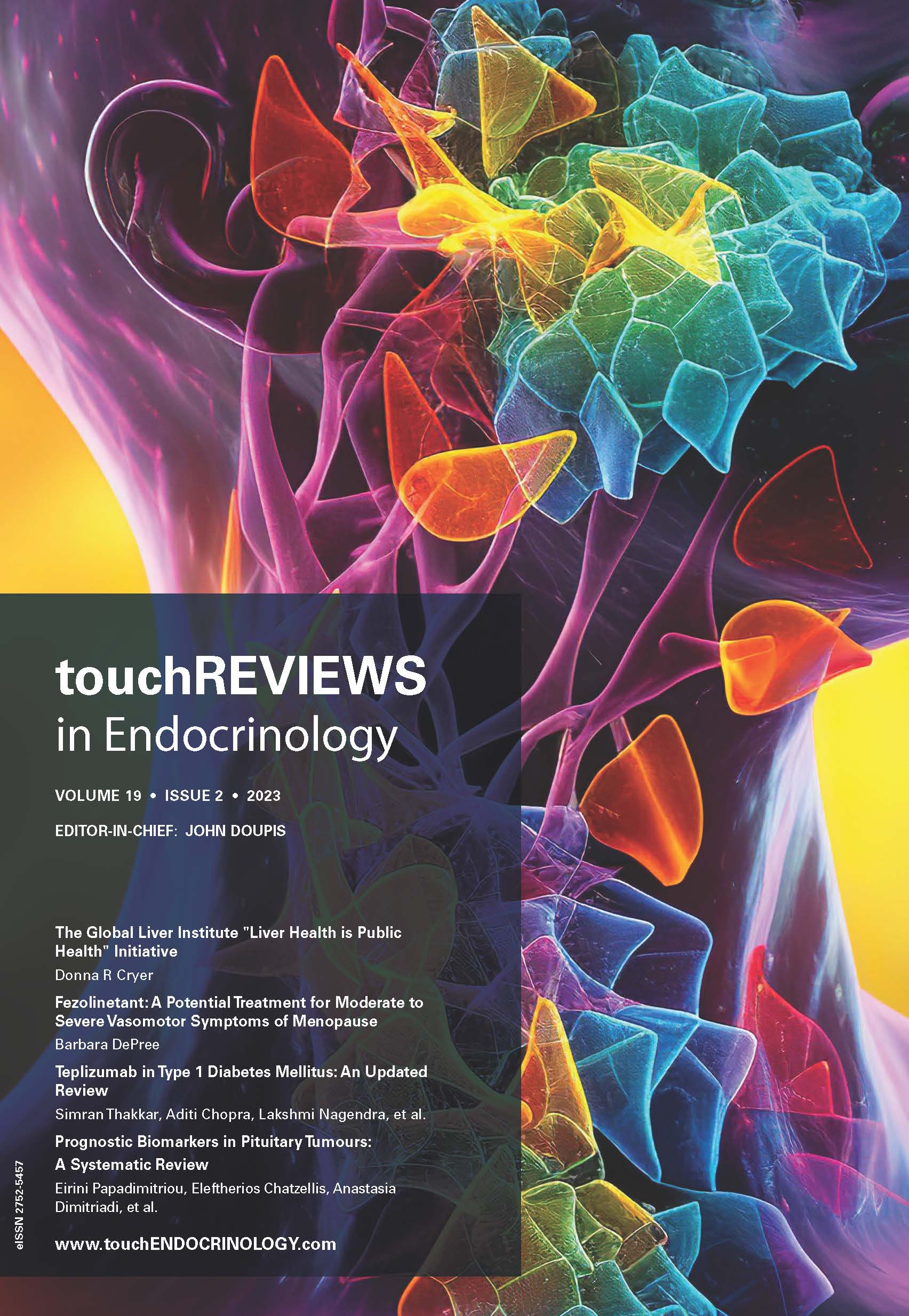EUROPEAN ENDOCRINOLOGY – VOLUME 8 ISSUE 1 – SUMMER 2012
Foreword
Clinical endocrinology has witnessed many surges in activity over the past year. Many events have been exciting and responsive to innovations and discoveries destined to improve healthcare, but many events have also posed tough challenges to the way patient care can be practised. For instance, the recent UN resolution 64/265 drawing attention to global problems […]
Editorial
‘Quality of life’, we believe, is becoming a more esoteric and often confusing term than first intended when it was originated. At one time just being alive constituted a primitive form of ‘quality of life’.
Diabetes Management
Type 2 diabetes is a progressive disease of the beta cells characterized by declining insulin secretion and varying degrees of insulin resistance resulting in hyperglycemia. It is a chronic progressive disease of increasing incidence. In the USA, 25.6 million people aged over 20 years have type 2 diabetes1 and the prevalence is projected to increase […]
Approximately 366 million individuals worldwide have type 1 or type 2 diabetes, and it is likely that global prevalence will rise to 552 million individuals by 2030.1 Currently, an estimated 4.6 million deaths are attributed to diabetes annually.1 Undisputedly, the best way to address this ‘diabetes epidemic’ is through a global commitment to prevention, early […]
Introduced into patient-directed self–management in the early 1980s, self-blood glucose monitoring (SBGM) is now recognized as integral to standard of care diabetes treatment for all age groups.1 Indeed, along with the development of stable and reproducible glycated hemoglobin (HbA1c) assays, SBGM made possible the achievement of intensive therapy and the design and conduct of the […]
Diabetic Nephropathy
Since the early 1980s, the clinical diagnosis of diabetic nephropathy (DN) has been based on the progression of albuminuria. Albumin excretion rate (AER) was categorised as normo-, micro- or macroalbuminuria based on retrospective studies of AER in type 1 diabetes prior to the introduction of angiotensin converting enzyme (ACE) inhibitors or angiotensin receptor blockers (ARBs). […]
Diabetic nephropathy (DN) was discovered by the British physician Clifford Wilson (1906–1997) and the German-born American physician Paul Kimmelstiel (1900–1970). Their first publication reporting the disease came out in 1936.1 Overt nephropathy secondary to glomerular disease usually occurs 15–25 years after the diagnosis of diabetes. In the past, it affected 25–35 % of type 1 […]
Diabetic Macular Oedema
Diabetic retinopathy is considered the most frequent retinal vascular disorder and is detectable in about 40 % of diabetic patients 40 years of age and older.1 Today, diabetic retinopathy is the leading cause of acquired blindness among young adults throughout developed countries.2 Population-based epidemiological studies have estimated that, after 20 years, diabetic retinopathy can be […]
Triamcinolone acetonide (TA) is a synthetic steroid of the glucocorticoid family with a fluorine in the ninth position.1 It is commercially available as an ester and represents one of the most commonly used steroid agents for the treatment of several retinal conditions.2
Pituitary Disorders
Acromegaly is an uncommon disorder that, in the vast majority of cases, is the result of a growth hormone (GH)-secreting pituitary adenoma.
Thyroid Disorders
Congenital hypothyroidism (CH) screening was introduced in 1974 and has become common practice, preventing the devastating neurological and developmental outcomes of untreated CH. Thyroid hormones are essential for normal brain development during early years.
Osteoporosis
At the outset, it is important to understand that the 2011 Institute of Medicine (IOM) recommendations for vitamin D1,2 can be taken at three levels of applicability. The first is the level of my own decision, for my own intake, informed not just by whim, but by my reading of the appropriate science. The second […]
Osteoporosis is a significant health concern that currently affects more than 10 million Americans, with an additional 34 million Americans at risk due to low bone mass. Osteoporotic fractures can lead to disabling pain, and nearly 30 % of patients with hip fractures require nursing home admission. In addition, 20 % of patients with hip […]

Trending Topic
Renal tubular acidosis (RTA) is characterized by the impaired ability of the kidneys to absorb filtered bicarbonate or to excrete titrable acid in urine.1 It manifests as normal anion gap (hyperchloremic) metabolic acidosis. RTA may be of four types: type 1 (distal RTA), type 2 (proximal RTA), type 3 (mixed RTA) and type 4.1 Type 1 […]
Journal Archive
touchREVIEWS in Endocrinology (previously European Endocrinology) is a peer-reviewed, free-to-access, bi-annual journal comprising review articles, case reports, editorials, special reports and original research. It features balanced and comprehensive articles written by leading authorities, addressing the most important and salient developments in the field of endocrinology.
Latest articles videos and clinical updates - straight to your inbox
Log into your Touch Account
Earn and track your CME credits on the go, save articles for later, and follow the latest congress coverage.
Register now for FREE Access
Register for free to hear about the latest expert-led education, peer-reviewed articles, conference highlights, and innovative CME activities.
Sign up with an Email
Or use a Social Account.
This Functionality is for
Members Only
Explore the latest in medical education and stay current in your field. Create a free account to track your learning.






